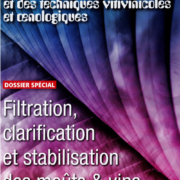Additive-free solutions for winemakers
More natural winemaking methods offer additive-free solutions for winemakers as demand for transparency on all foods and beverages continues to grow
STARS can guarantee stability and improve wine quality with zero additives and zero wine loss!
A recent editorial by renowned French winemaker and researcher, Jean Luis Escudier outlined a major shift in European winemaking this year when the European Alcohol and Beverage Industry, in response to consumer demand for more transparency and following a series of meetings with the EU Commission, proposed a self-regulating agreement in which producers will list nutritional information and ingredients for their products.
The introduction of this agreement could be an indication that change might slowly be coming to the world of winemaking with respect to transparency and producer accountability. Producers may soon be unable to hide behind Federal law (that does not require labeling for alcoholic beverages above 1.2% alc.) or claim to be “all natural” or “low intervention” when listing a long list of additives, including the one used during the stabilization process, on the back of their labels.

Should the labeling law change, winemakers will either have to employ new methods of winemaking, that do not involve so many additives, or hope the more informed consumer will still buy their product. One non-additive solution winemakers could be embracing is STARS, the membrane electrodialysis technology that offers an additive-free stabilization method of winemaking.
Membrane electrodialysis technology was developed by INRA (the French National Institute for Agricultural Research) and Oenodia and has been used in winemaking since 1997. STARS is a membrane process that uses a charged current to extract the anions and cations in the calcium and potassium ions. This leads to wine stability without the use of any additives or loss of wine and the process is in a closed system so no oxygen pickup occurs either.
Yannick Le Gratiet, Director of Oenodia, talked about the process and how it came about, “It came down to the same fundamentals that the consumer is worried about today: What is in the wine? We wanted to create a process that would stabilize the wine while retaining the quality without adding a bunch of chemicals to it. We need to have fewer additives in the bottle and focus on the characteristics of the wine.”

Yannick is a big proponent of producer transparency. As a former winemaker, he understands the necessity for the additives in the market but believes there are better non-additive ways to achieve high-quality wine. STARS is the only system on the market to see 100% efficiency from beginning to end and has been doing so since the first unit was installed in 1997 and in that time not one bottle of wine has come back unstable. In contrast, additives can fail down the line causing haze or turbidity when you thought your wine was stable. There is no guarantee! With STARS, there is, and it has been proven over the last couple of decades.”
Oenodia attributes its success with STARS, not only to the ED technology but also to the development of the Stabilab, a test to measure the wine instability before treatment (DIT Test), provide a specific treatment number to get the wine stable at -4’ C and another test after treatment to check the wine and verify results (ISTC50 Test).
“We preach precision winemaking,” says Yannick, “There is no guesswork involved in the STARS system. Our compact, efficient and easily operated units have been developed by a team of skilled technical engineers and winemakers who bring invaluable expertise and experience.”
The STARS system is the only 100% efficient stabilization method with no additives, no oxygen pickup, and zero wine loss that is on the market. Last year they added STARS XF to their STARS line which combines a crossflow filtration system with the original STARS system so you can stabilize and filter your wine at the same time.

When talking about the future of the STARS system, Yannick is very positive that growth will continue at an accelerated pace. He says, “There are currently 250 stationary systems in wineries worldwide and we would like to see close to 450 units by 2025. Our goal is to reach 4 billion bottles stabilized by the STARS system, which would only account for about 10-15% of the worldwide wine market. That would mean that millions of consumers will enjoy wine without stabilization additives.”
“The market in the US continues to grow rapidly for us” he added. “In addition to our stationary unit sales, our STARS Mobile Service department now operates 3 mobile units from Napa offering our STARS pH, STARS Stab and new STARS XF (which combines STARS with crossflow filtration) processes. The 3 units allows us to not only provide our stabilizing service but we can also carry out trials as part of our stationary equipment sales. Customers are drawn to our single pass and 100% guarantee process which ensures “wine to bottle” quickly with quality, color, and stability intact along with zero wine loss, which along with everything else deliver a very attractive ROI on STARS.”
For more information, you can stop by the OENODIA booth #113 at WINEXPO on December 6th in Santa Rosa or at the UNIFIED Symposium, Booth #2406 in Sacramento, Jan 29th and 30th. Or you can visit us online at www.oenodia.us.


